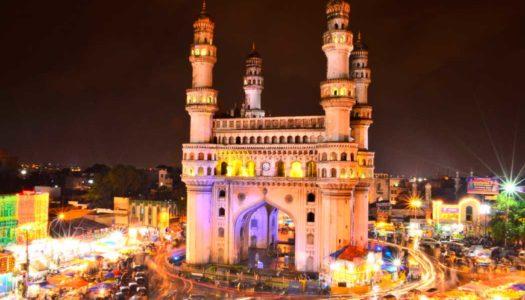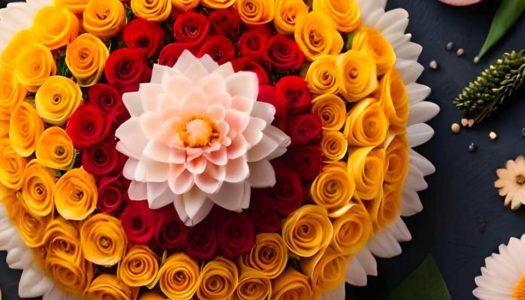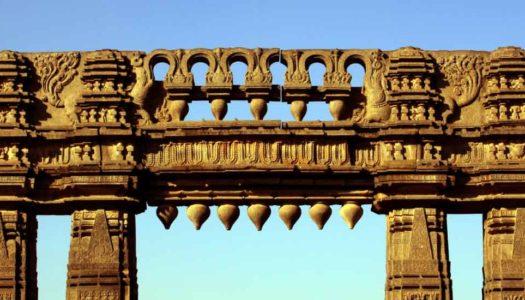Bonalu is a vibrant festival that is celebrated in the twin cities of Hyderabad and Secundrabad of Telangana state. The celebrations are a way in which the people offer their prayers and thanks to Goddess Mahankali or Shakti. It is believed in Telangana that Goddess Mahankali protects and safeguards anyone who comes to her with truth and devotion in their hearts. Bonalu is the occasion when they celebrate the presence of the Godess’s spiritual presence and indulge in traditional activities. The word ‘Bonalu’ is derived from the Telugu word ‘Bhojanalu’ which means ‘meals or a ‘feast’.
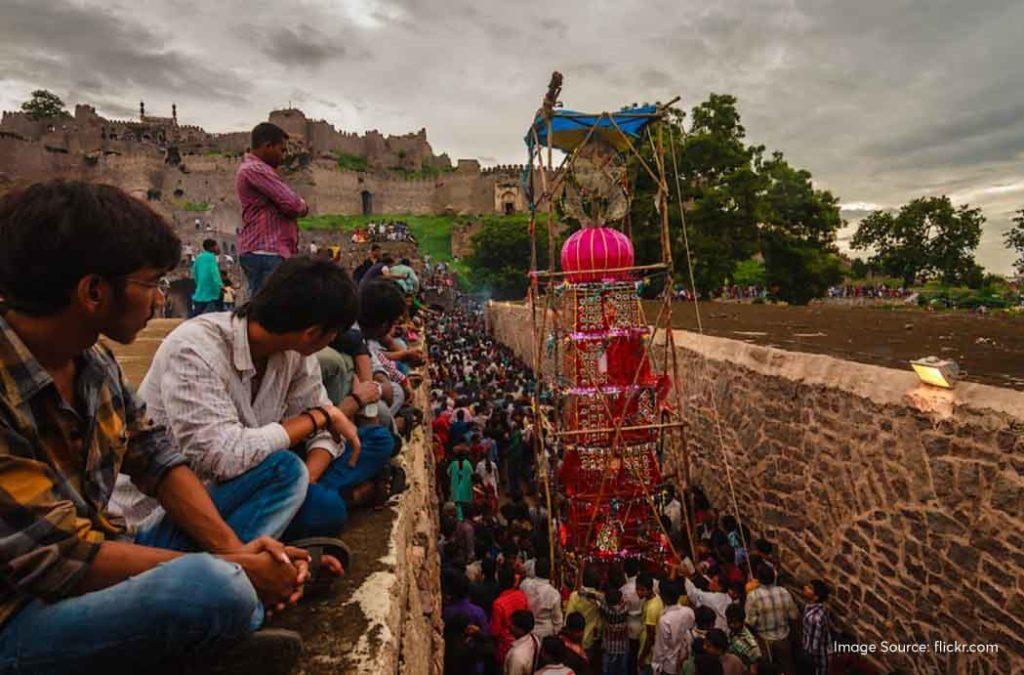
You will be surprised to see the amount of fanfare that Bonalu bring to the state. Goddess Mahankali is worshipped in various forms during this festive season. Some call her Maisamma, others call her Nookalamma. Some refer to her as Pedamma while others pay their respects to Yellamma. Locals believe that the goddess is anywhere and everywhere during the Bonalu festivities.
Let us know more about the story of Bonalu, its origins in the Telangana state, the different deities of Bonalu, Pooja preparations and the rituals.
Read on!
The Story of the Bonalu Festival
The Bonalu festival’s history dates back to the 19th century when the region was severely hit by a devastating plague. People were dying and the disease was spreading faster than the healers could cure. During this time, the soldiers of Hyderabad were stationed in Ujjain of Madhya Pradesh. Hearing about the plague that was affecting the lives of their people in Telangana, they prayed to Ujjain’s Goddess Mahakali. They sought her blessings and made a promise that if she eliminated the plague from the region, they would build her a temple and offer her the grandest feast once every year. When they came back from Ujjain, they noticed that the epidemic slowly started to subside and people started getting better. This is when they fulfilled their promise and built the Ujjain Mahakali (referred to as Mahankali in Telangana) temple in Hyderabad. People believe that Goddess Mahankali continues to protect the locals from evil spirits and life-threatening diseases. They thank her for her divine intervention and blessings by celebrating the Bonalu festival every year in the Goddess’s honour.
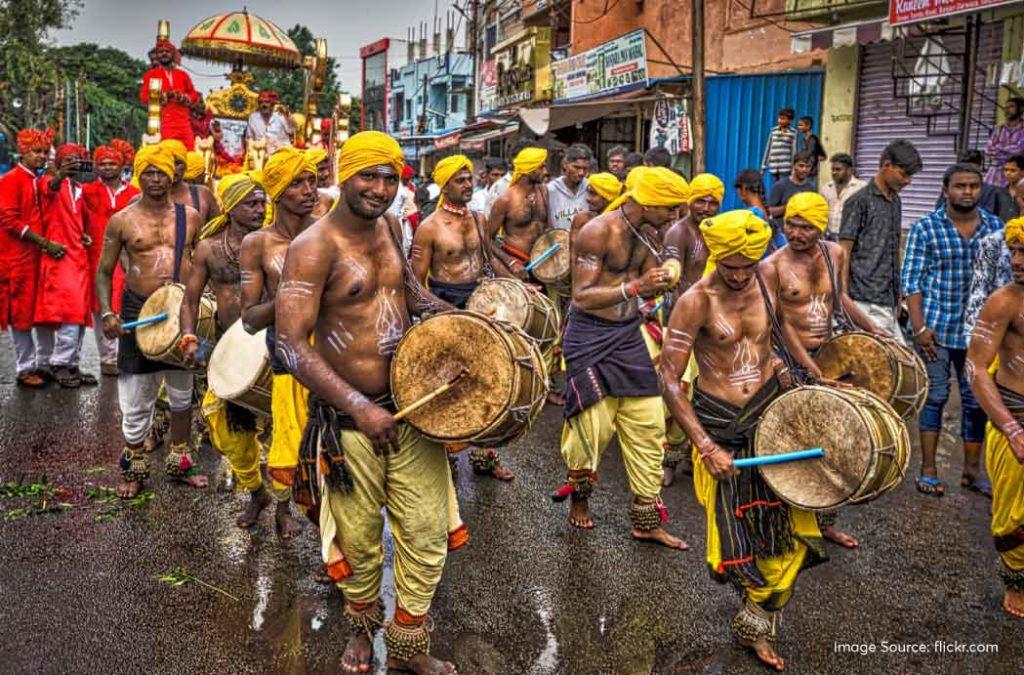
There is another legend that says that Goddess Mahankali believes Telangana to be her maternal home. During the Ashada month, she comes back to her maternal home and the people welcome her. They offer vermillion, turmeric, kumkum and a lavish feast to keep the Goddess happy. She in return spreads her positive energy along the region and combats any evil spirits that try to harm her devotees.
Cultural Significance of the Bonalu Festival
Bonalu festival holds great cultural significance among the Telugu-speaking crowd of the Telangana region. This is the time when people come together as a community to laugh, spread smiles and celebrate in harmony. The women dress up in traditional attires, usually, Pattu sarees or half sarees for the young girls and men wear dhotis or cotton pants and shirts. The families clean their houses well in advance. Some would also do spiritual cleansing with incense sticks. Then they bring home flowers, fruits, neem leaves and mango leaves to decorate their houses, the gates and entrances. You will find colourful Rangolis in the verandahs.
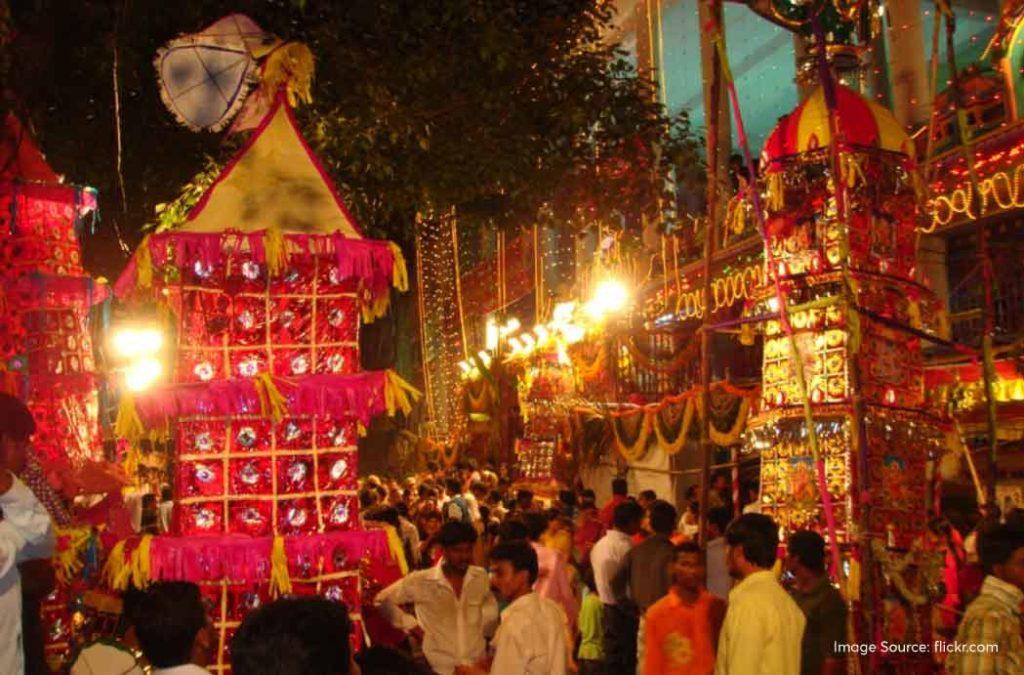
Traditional music and dance are integral parts of the Bonalu festivities. The celebrations are incomplete without the folk songs that hail the mighty Goddess or the dance that mimics the protecting deities. Several artists also make money by dressing up as deities and entertaining the crowd. People make prasad at home and distribute it among family members and neighbours.
There are grand processions on the road where people randomly join the crowd and dance, irrespective of ethnicity or religion. The fervour and energy are too palpable to ignore! Bonalu definitely boosts the community spirit and brings people together.
Pothuraju, Rangam and Ghatam
Pothuraju, Rangam and Ghatam are the three main aspects of the Bonalu festival.
Pothuraju is believed to be the brother of Goddess Mahankali. He is the deity who will keep evil spirits and negative energies away from the processions of Bonalu. The ladies from all households make their ‘Bonams’ or food offerings. They fill food items in an earthen pot and decorate them with turmeric, flowers and neem leaves. They place these pots on their heads and walk in a procession to offer their food to Goddess Mahankali. Pothuraju stands at the beginning of this procession.
A man who is dressed up as Pothuraju will lead the procession to Goddess Mahankali’s temple. He rubs his body with turmeric and vermillion, has long hair, anklets on his feet, animal skin along his waist and wide eyes to look around for any terror. He takes the ladies to the temple by continuously lashing his whip. He also keeps shaking the neem leaves in the air to keep negative energies away.

Women who are holding the ‘Bonam’ during Bonalu are said to be possessed by the spirit of the Goddess. So, Pothuraju aims to protect the people as well as the divine power of his sister.
Rangam is a ritual that happens during the Bonalu festival. One of the ladies who reaches the Goddess’s temple will be possessed by the deity herself. She turns into the oracle. She predicts how the coming year will be and what needs to be done to maintain peace and harmony. She will also mention the things that the people are doing and invoking the wrath of Mother Earth. This is when people can ask their own questions and know about the well-being of themselves and their families. Only after the Rangam ritual is done will the last and final procession of the festival will happen.
Ghatam is the last procession of the Bonalu festival. One earthen pot is decorated in such a way that it resembles the face of the goddess Mahankali. A priest will carry this pot to a water body, accompanied by loud music, drum beats and a lot of dancing from the devotees. Traditionally, Ghatam or the earthen pot needs to be taken by a priest on an elephant. Each city in the state of Telangana will have one Ghatam. All these Ghatams will ultimately be immersed in water on the last day of the Bonalu festival.
Several regional festivals are celebrated in Telangana. Bathukamma Festival is another beautiful occasion when people pay their respects to Mother Nature.
Dates of the festival
According to the Hindu calendar, the Bonalu festival comes in the Ashada month. This coincides with July and August in the Gregorian calendar. This is not a one-day festival but a month-long feast. In 2024, the dates will be 7th July to 4th August. The Bonam offerings happen on all Sundays of the Ashadam month.
Pooja and celebrations
During the Bonalu festival, women buy earthen pots and fill them with food items like rice, jaggery, curd and water. Some would heat jaggery, water and cooked rice to make a sweet dish while others would mix curd, boiled rice and water. These earthen pots are then neatly covered and lined with neem leaves. The ladies also apply turmeric to the outer circumference and add kumkum on all four sides. A little bit of sandalwood water or chandan is sprinkled on the pots. These pots are what we call the ‘Bonam’, a food offering that will be made to Goddess Mahakali in the temple. On the top of the pot, the women place a small diya and light up camphor in it. This is called the ‘Bonam Jyoti’ that needs to burn until they reach the temple.
When ladies step out of the house with Bonam on their heads, they need to walk barefoot and offer the pot to the deity. While they progress toward the shrine, kids, men and other relatives dance and sing to the drum beats and traditional music. A man dressed as Pothuraju will lead this procession to the temple.
The Bonalu celebrations have a pattern that is followed every year.
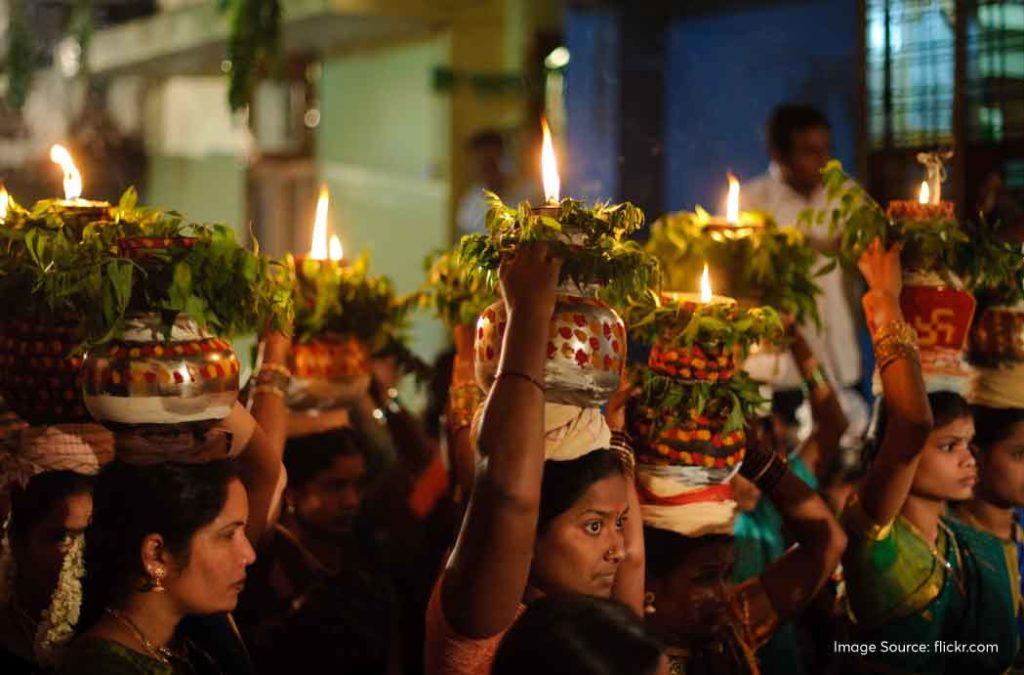
On the first Sunday of Bonalu (7th July), the rituals will be carried out in the Shri Jagadamba Temple in Golconda Fort. These are the first Bonalu (plural of Bonam) that will be offered for the year. Women who cannot make it to this temple can offer their Bonam anywhere in the nearest temple. However, the main ritual, the centre point of the spiritual celebrations is going to be the Jagadamba Temple.
On the second Sunday of Bonalu, the earthen pots will be offered to the deities in the Yellamma temple of Balkampet and Ujjaini Mahankali Temple in Secunderabad. This day is also called the ‘Lashkar Bonalu’, the auspicious time when the feast is being offered to Goddess Mahankali in the abode that was built for her by the Hyderabadi soldiers.
On the third Sunday of Bonalu, the pots will be offered to Katta Maisamma and Pochamma temples in Chilkalguda. They will also be offered at the Mateshwari Temple in Old City near Charminar.
The offerings made at these temples are the first offerings from the first procession. After that, people can make offerings to Goddess Mahankali in any temple near them.
On Bonalu, people wake up early in the morning, take a head-to-toe shower, dress up in new clothes and cook to make the Bonalu. They decorate the pots, light the Bonam Jyoti and set out on the procession.
Animal sacrifices are also made toward the end of the Bonalu celebrations. The meat that is cooked is received as prasad and is distributed among family members and the underprivileged.
Cities that celebrate Bonalu
Bonalu festival is predominantly celebrated in the Hyderabad and Secundrabad regions. The festivities are grand and more conspicuous in the capital city. That doesn’t mean that people in other cities of Telangana do not celebrate on Sundays. Regions like Warangal, Karimnagar, Siddipet, Nizamabad, Khammam, Mehboobnagar, Vikaranad, Nalgonda and Medak also celebrate Bonalu with enthusiasm.
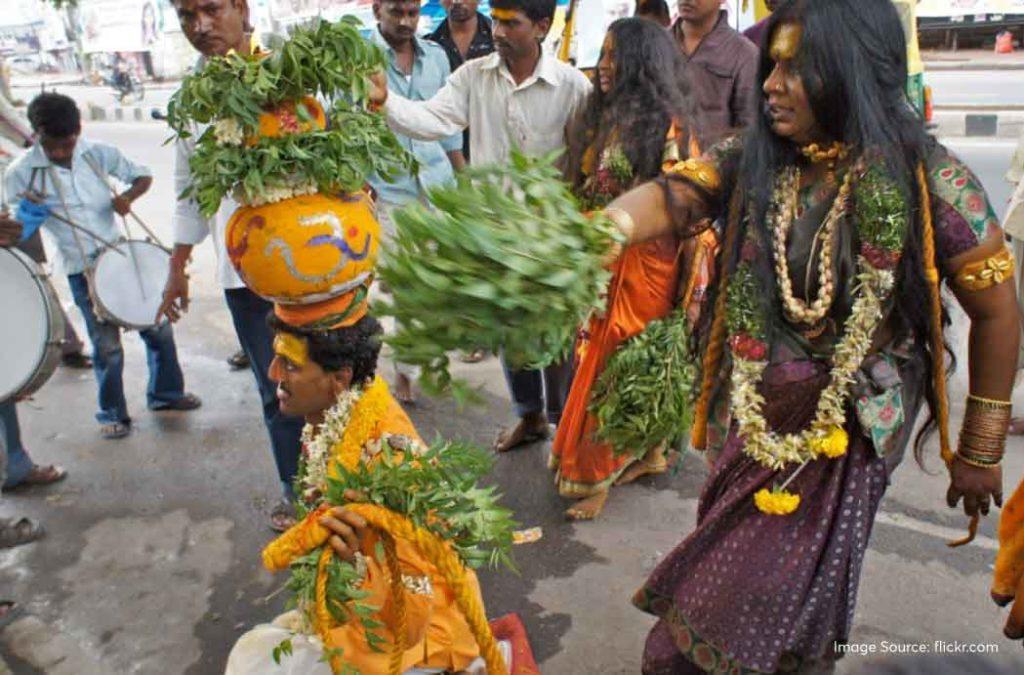
Most of the cities, towns and villages of the Telangana state celebrate the Bonalu festival. The families that migrated from Hyderabad to Andhra Pradesh after the state bifurcation celebrate the festival in AP, though the festivities are not as grand as here.
How to reach Hyderabad?
If you want to witness the best of the Bonalu festival, then we suggest that you book your hotels in Hyderabad and stay here for at least the first two Sundays to witness the grandeur of the traditions and rituals.
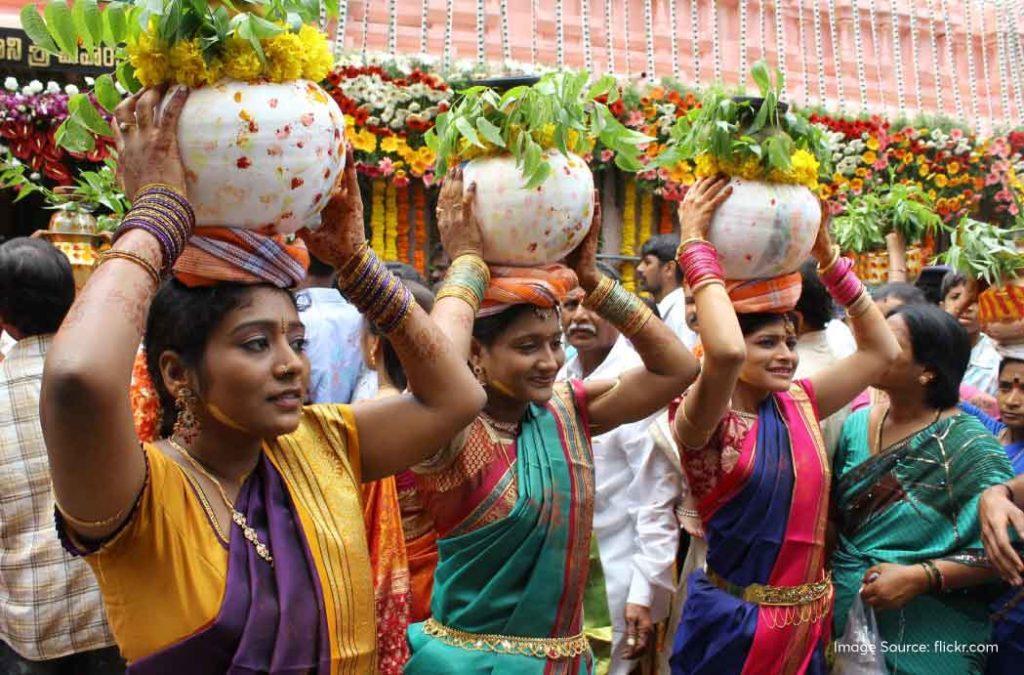
This is how you can reach Hyderabad.
By Air
Hyderabad’s Rajiv Gandhi International Airport is well connected with airports of other major Indian cities. It also receives international flights regularly from countries like Qatar, Sharjah, and Dubai among other places. You can take a flight and land at Hyderabad airport and take a taxi or the government bus to reach the heart of the city.
By Rail
Hyderabad has three railway stations – Hyderabad Railway Station, Secundrabad Railway Station and the Kachiguda Railway Station. You will find the trains run between these stations and other Indian cities like Chennai, Bengaluru, Kochi, Goa, Kolkata, Mumbai, Delhi and Pune. Once you reach Hyderabad, you can easily find auto rickshaws or even hire an Uber to go around the place.
By Road
NH 65 passes through Hyderabad city so the ones coming from the northern part of the country must aim to join this route. As for the ones travelling from states like Karnataka can take NH7 which passes through Hampi and eventually leads to Hyderabad.
Each ritual that happens during the Bonalu festival is closely linked to the beliefs of the local people. The devotees trust that the Goddess graces them with her presence during the festival and go out of their way to keep her satisfied and happy. With loud music, magical drum beats, mass dance steps and mouth-watering feasts, Bonalu is a grand affair that dazzles anyone who sets foot in Hyderabad.









